Teacher's Toolkit
Using a Systems Thinking Approach to Figure Out Why a Ball Drops, Bounces, and Stops
This column provides how-to strategies and practical advice for the science teacher. In this issue, learn how to develop students’ systems thinking skills and have them apply these skills to discover and explain the energy conversions and transfers that take place in simple systems.
While the term systems is identified as a crosscutting concept of Systems and System Models (NGSS Lead States 2013), systems thinking is much broader. Systems thinking results in a deep understanding of a system that allows you to predict its behavior and strategically modify the system to produce desired effects. Teaching systems thinking is challenging due to its complexity and the complexity of the systems to which it is typically applied. By applying systems thinking to simple systems, students and teachers can develop systems thinking habits, which can then be applied to more complex systems. Here, I describe how students’ systems thinking skills are developed as they apply these skills to discover and explain the energy conversions and transfers that take place in simple systems.
Getting started
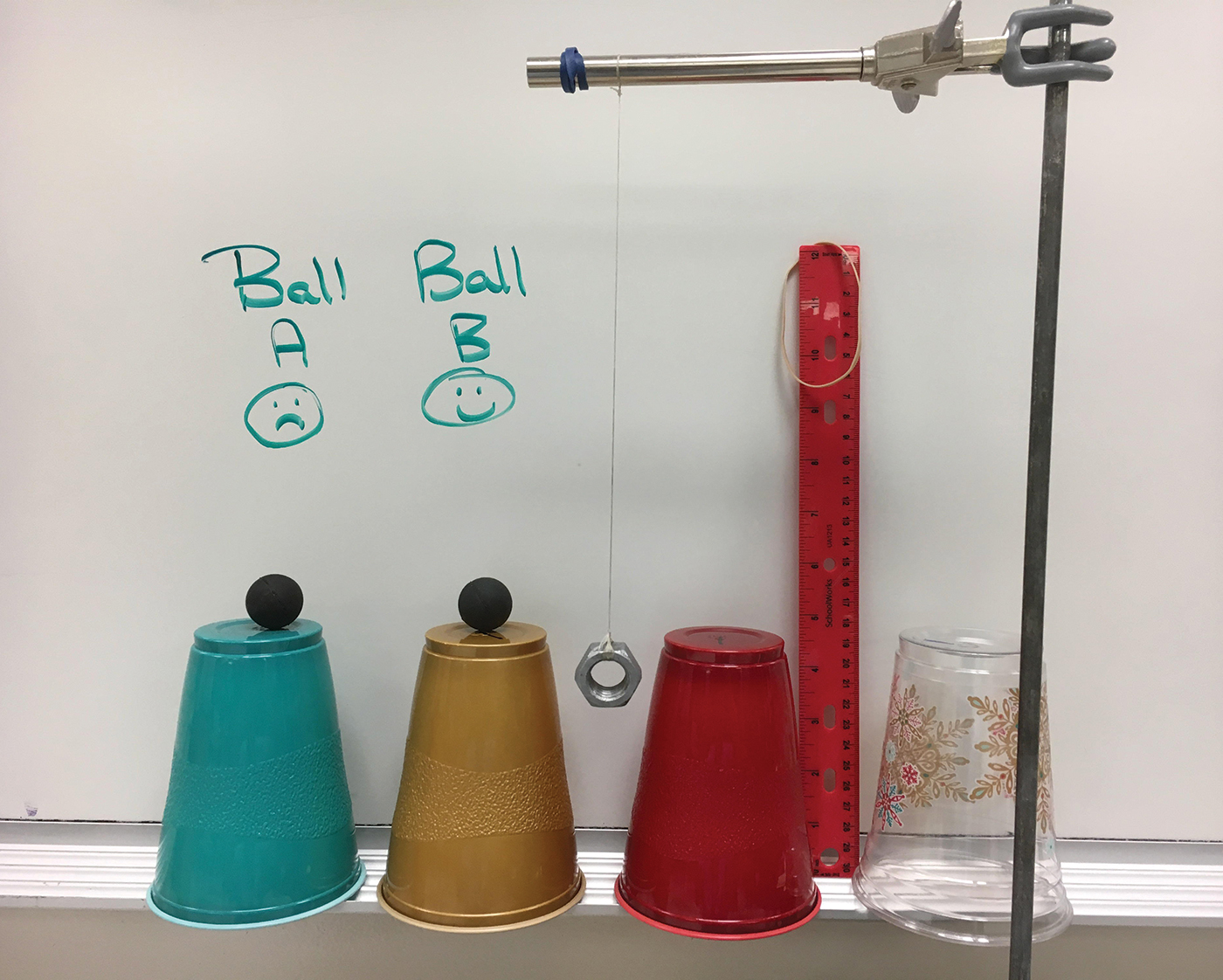
The overarching goals for the unit are to learn about energy conversions and transfers, and to develop systems thinking skills. In short, students have to figure out and demonstrate their understanding of energy changes by explaining why a ball (ball B) bounces and stops. The equipment used in this unit included four apparatuses (Figure 1) made up of (a) ball A, (b) ball B, (c) a simple pendulum, and (d) an elastic band stretched over a ruler (balls A and B are also known as “bounce no bounce”; balls are available online).
Ball A is selected to provide a discrepant event to engage students and get them beyond the notion that balls bounce because they are balls and that is what balls do. The study of all the items helps students learn about energy transfers. Figures 2 and 3 are provided as summaries of what students are expected to discover for each of the apparatuses.
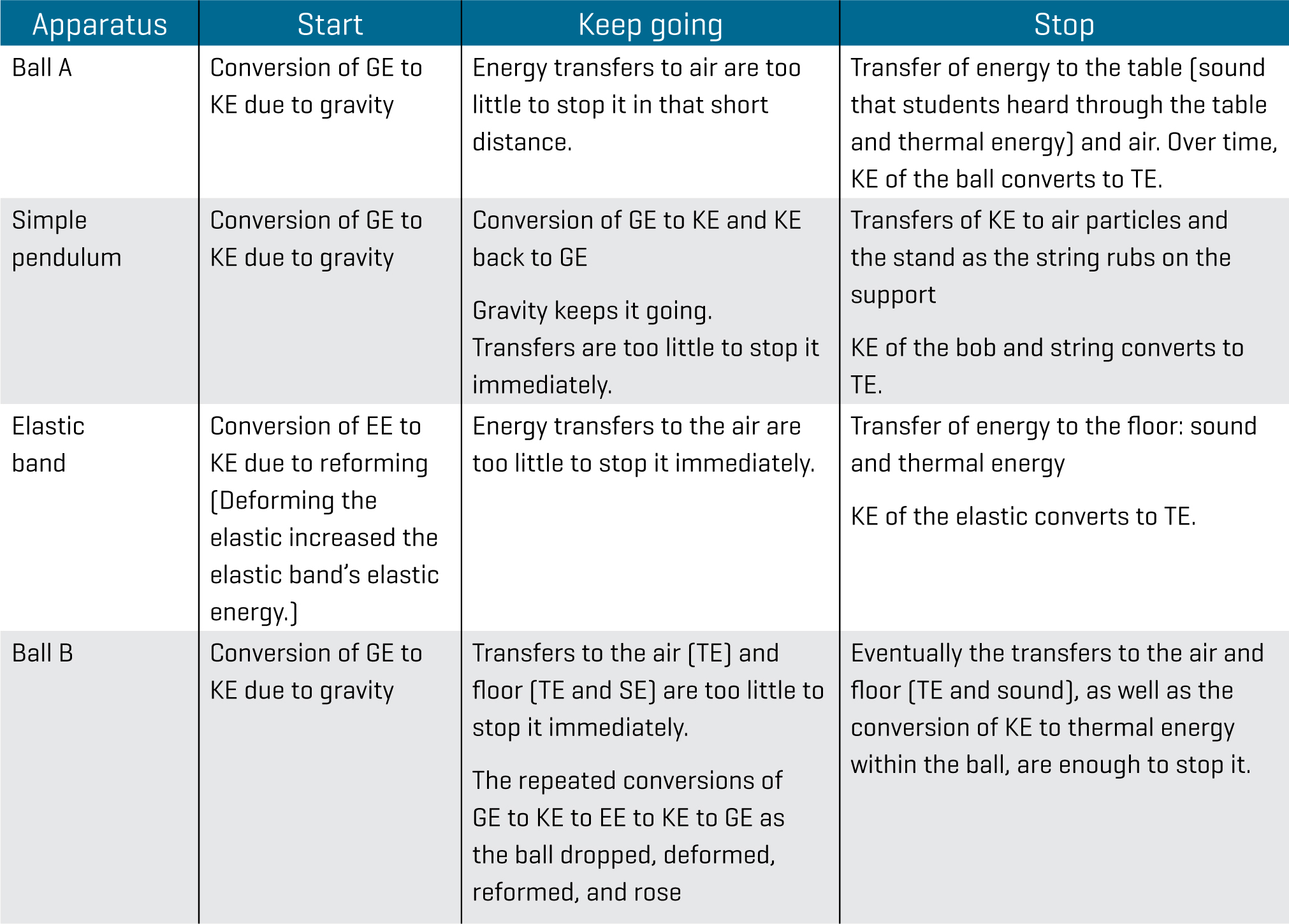
To guide students when experimenting, handouts are developed for each of the apparatuses. The handouts (Figure 4; also see Online Supplemental Materials) give the goals of their investigations, instructions, guiding questions that systems thinkers ask, and space for students to record their ideas, observations, and models. The handouts are also made available online, allowing those choosing to work online voice-to-text and text-to-voice opportunities, as well as the ability to add photos and additional information, such as translations.
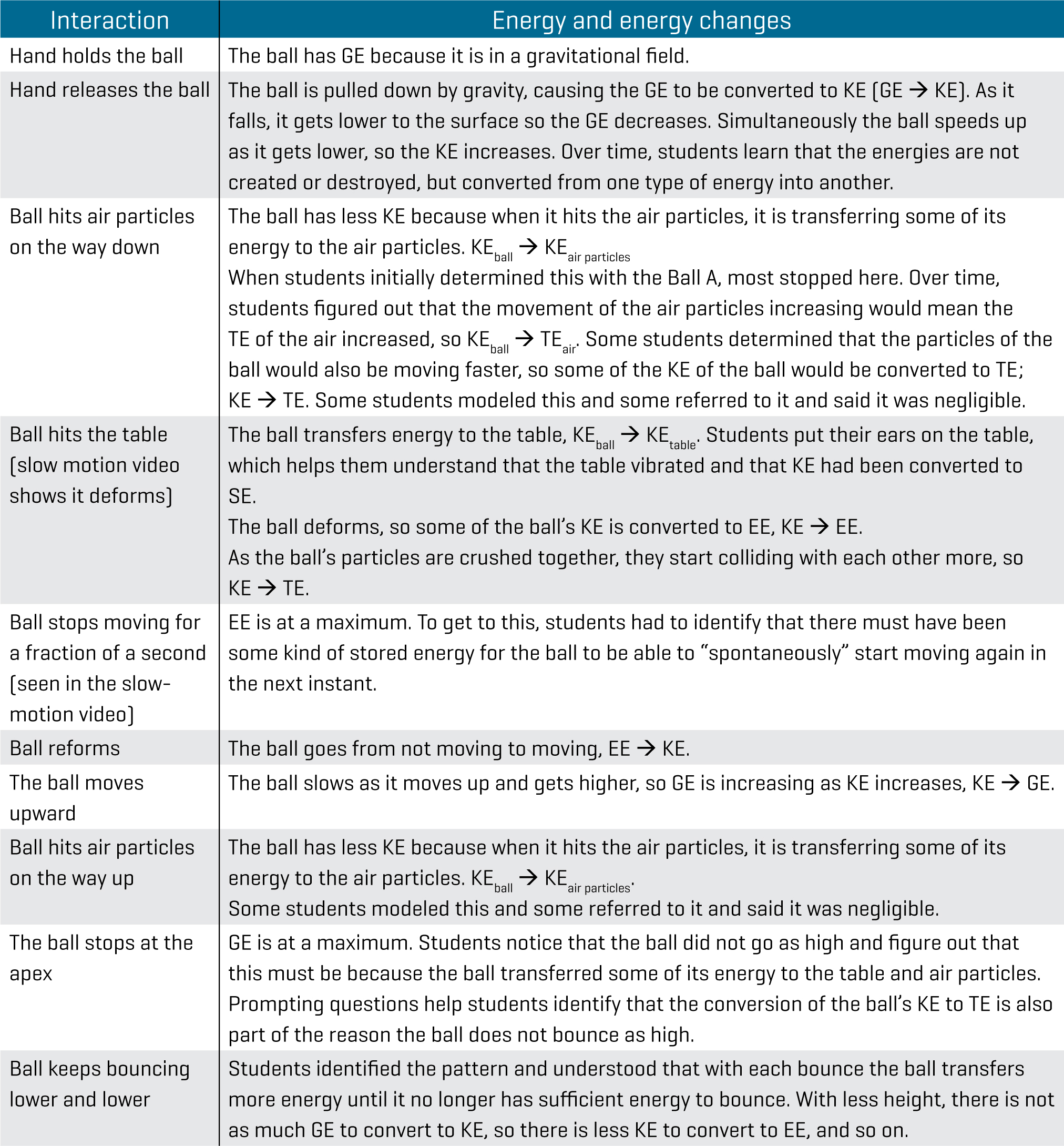
Students are strategically assigned into groups of three or four to promote peer support and maintain diversity (Kagen 2018), and to bring different perspectives and strategies for figuring out how the apparatuses work.
As a pretest, students record their observations of ball B and describe its movement as it is released from 20 cm (8 in.) above a desk. Students then try to explain why the ball started moving, kept bouncing, and eventually stopped.
Next, students are provided with a self-assessment handout I constructed that contains a list of systems thinking skills derived from those in Arnold and Wade 2017 and the Waters Foundation 2018 (see the sidebar on page 80). Students are asked to select the three most important systems thinking practices for understanding why a ball bounces and stops. Students then share why they selected the skills they did, both within their table groups and then with the whole class. Responses are diverse, and the following are just a few examples. Some students said all you need to understand a system is to identify how the parts interact. Another student said that it is pointless to know how the parts interact if you don’t know the function of the system. One student identified that studying the changes over time might help with understanding why the ball stopped. The purpose of the exercise is to get students thinking about systems thinking, with the goal of developing a deeper understanding through application, practice, and further discussion as the unit continues. Students then rank their systems thinking skills.
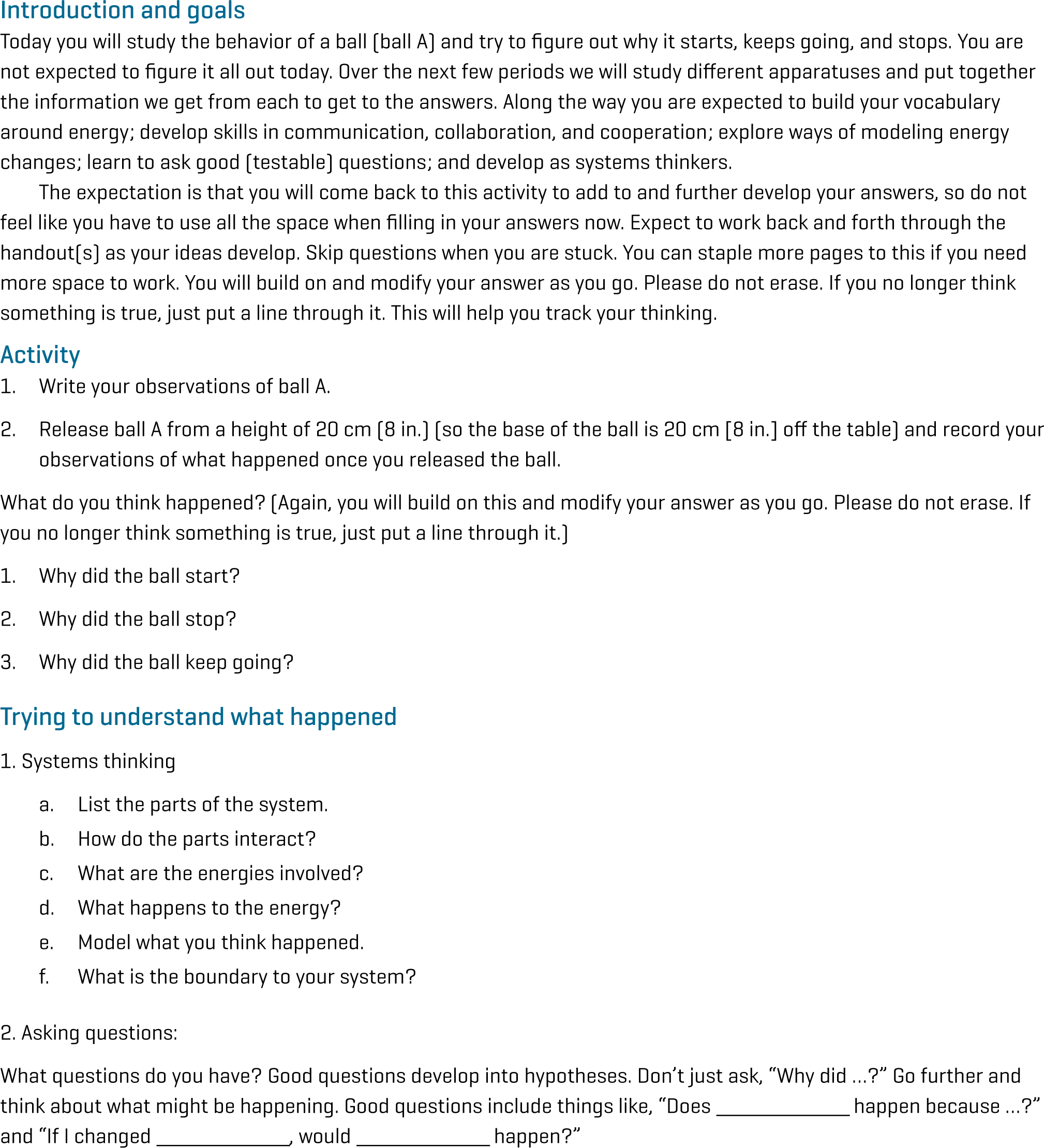
Exploring the apparatuses
Students are asked to try to figure out why ball B (in the demo) bounced and eventually stopped by using systems thinking practices to understand the movement of other apparatuses. Together, the class reviews the handout “Lesson 2: Ball A” (Figure 4; see Figure 5, p. 81, for a student work example). Students are also shown how they would release a bob from a 30° angle from a vertical position, and stretch an elastic band to 12 cm (4.7 in.) on a ruler and watch it fly. I choose not to show students ball A so they can discover on their own that it does not bounce. A no-walk zone is established in the classroom where students can safely release the elastic band. All of the apparatuses (one set per group), as well as safety goggles (to be worn throughout all of the experimenting), are made available. Students receive their handouts (see Online Supplemental Materials) for each of the apparatuses.
Next, students are introduced to the term physics as the study of matter and energy and their interactions and to the term energy as the ability to do work. Students are then challenged to develop an understanding of energy by studying different apparatuses to figure out why a ball bounces and eventually stops.
The apparatus students start with is ball A (Figure 1). Students hold the ball at 20 cm (8 in.) as described in their handout and are told not to release the ball until I say, “Go.” Students assume the ball is like the ball that bounced during the pretest because they look alike, and are surprised when it does not bounce.
From this point on, groups work at their own pace. Apparatuses are tested in the following order, but students can go back and retest any of the apparatuses: Ball A, the pendulum, the elastic band stretched over a ruler and released, and ball B. As students work with the apparatuses, students record their observations and ideas on their handouts. Each group establishes their own way of working through the handout. A strategy that works well is to have different group members lead for each of the instructions or questions on the handout. As students work, I circulate, observe, and ask and answer questions. Criteria for continuing to the next apparatus do not require being able to answer all of the questions on the handout, but rather having identified some of the interactions and having good questions to answer when studying the next apparatus.
Formative assessment takes place as I circulate and speak with individuals and groups. Tracking what groups know so I can support them without giving anything away is challenging. I try different ways of note taking, but what works best is having students within the group update me on what they have learned before we start conversations. This also serves as a review for students. Individuals, groups, and the class are questioned along the way to push student thinking, and students ask questions that they try to answer. Response types depend on the question and include choral responses, thumbs up or down, fingers indicating which answer is correct, and individual answers. Some of the questions include: Would energy be involved? Where did the energy come from? What kind of energy is it: potential or kinetic? What if we did the same thing in a vacuum, a pool of water, or an open space? How could you get the ball to bounce for longer or shorter periods of time?
Making students’ understanding visible allows me to identify and address misconceptions and provide specific support to individuals needing it. For example, some students think that kinetic energy “overpowered” gravitational potential energy as the ball fell. Discussions about where kinetic energy comes from and why it would not “overpower” gravitational potential energy help students consider the possibility of energy conversions. Some students suspect that the ball stopped bouncing because of gravity. Although a full understanding of the physics involved in a ball bouncing is beyond the scope of this article, having students consider what would happen without gravity helps students understand that gravitational potential energy that helps to keep the ball bouncing (Figures 2 and 3).
Explaining the system
Students are allowed and sometimes encouraged to check in with other groups to share ideas and to look at and add to a poster that collects students’ questions. Once every period, the class discusses its findings (up to the section the slowest group has reached). Over time, consensus models are built, and important principles and definitions are recorded in notebooks. This includes defining the different types of energies, differentiating between potential and kinetic energies, noting that energy can be converted and transferred but not created or destroyed, identifying that things can start due to a conversion of a potential energy to a kinetic energy, and noting that if something makes noise, it must be transferring energy and that would contribute to it stopping (e.g., the elastic, bob, ball), and modeling energy conversions and transfers using arrows (as in Figure 3).
When identifying the parts of the systems, students quickly identify the apparatuses, such as the ball; the string, bob, and stand; the elastic and ruler; and the surface as parts of the system. Over time, often in trying to explain what is happening in the system, the hand(s) interacting with the apparatus, gravity, air particles, and energy are added to the list. The latter three broaden students’ understanding of “parts” to include things that are invisible.
Identifying interactions is also an important part of systems thinking. Students are encouraged to describe the interactions sequentially, and think about how those things happen. With some prompting, students learn to distinguish between describing what happened and identifying the interactions. Taking the perspective of the parts they are considering helps with this. For example, rather than just stating that the ball falls, they state that the ball was pulled down by gravity and hit air particles on the way down.
Tracking changes in energy
At the start, many students are not familiar with the different types of energies. But by considering that energy is what can cause change, and thinking about the interactions they identify, they are able to figure them out. For example, there is typically initially some discussion about whether the ball had energy while it was being held in the air. Students identify that the ball fell because gravity pulled it down (the ball would not fall in open space). They conclude that there must be a type of energy caused by gravity. At this point, I identify the energy as gravitational potential energy. Similarly, a stretched elastic can cause change (elastic energy), sound can cause change (sound energy), and moving things can cause change (kinetic energy). Thermal energy is not as obvious, but by identifying that things moving through air would hit air particles, making the air particles move faster, and applying knowledge of phase changes, students figure out that the particles moving faster are associated with things being warmer. They extend this thinking to explain that the same thing would happen to surface particles when the object strikes the surface; the kinetic energy of the object’s particles would increase. Thermal energy is defined as the sum of the kinetic energies of the microscopic particles of an object.
Once students identify the energies involved, they begin to track changes in energy. For example, as students identify that objects held higher can cause more change than objects held lower, they conclude that gravitational potential energy must decrease as an object falls. Similarly, because faster-moving objects can cause more change than slower-moving objects, a falling object must gain kinetic energy as it falls and speeds up. Students then notice that the reverse happens as the ball bounces upward. This leads students to the concept that energies could interconvert (change from one form to another), and that the total energy in the system might not change.
One of the most challenging skills to develop as a systems thinker is identifying where a system stops and starts, as everything is connected. Even discovering this skill is very important. Over time, students pick up on the idea that a system’s boundary depends on the question trying to be answered. For example, if a person is interested in studying the energy conversions of a ball bouncing, the area in which the ball moves sets the boundary. If the question relates to all the transfers that take place when a ball bounces, then the boundaries are much larger because sound travels through the surface and air and energy is dispersed as heat. Trying to identify the boundaries for energy transfers leads to discussions about the dissipation of energy. Students learn that boundaries are dependent upon context and that it is typically not clear where to draw them, especially because what some consider inputs and outputs of a system, others consider a part of the system. Students learn that systems are messy and that, when studying systems, an eye has to be kept on what is going on outside of the system delineated by the boundaries ascribed to them, as outside factors may still influence the system.
Modeling ideas
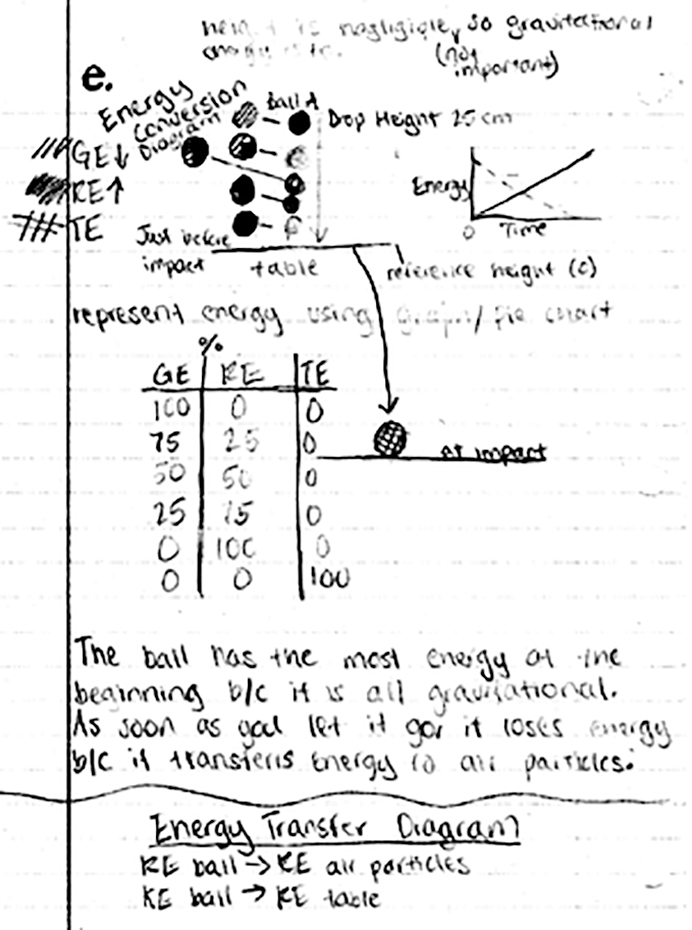
Students come up with multiple ways of modeling their ideas. Many students draw stop-action diagrams and label them. Some use graphs, such as changes in different types of energy over time. The class represents energy conversions with arrows; for example, the conversion of gravitational potential energy (GE) to kinetic energy (KE) would be written as . Energy transfers are similarly represented. For example, a ball hitting air particles that transfers its energy to the air is modeled as:
Student work from their Lesson 2: Ball A handout modeling energy conversions and transfers for ball A held, falling, and stopping when it hits the table. Recall that ball A does not bounce. While the work is not entirely accurate, it shows the emergence of understanding.
Students use pie charts to approximate the percentages of the different types of energy possessed by the balls, bob, or elastic before, while, and after they are moving. For example, when a ball is held, it only has gravitational potential energy, so GE is at 100%. Halfway down, half of the GE would have converted to KE, so GE is at 50% and KE is at 50%. Just before impact, all the GE would have converted to KE, so KE would be at 100%, and so on. See the student work in Figure 5 for some examples of modeling.
Reflection
While many of the items on the systems thinking self-assessment handout are not explicitly part of the handouts used to record data and thinking, and other systems thinking skills are not included at all, through questioning individuals, groups, and the class, I learned that students were able to identify where they were applying these skills. Students identified that bouncing and swinging back and forth are patterns. Without formal discussions of scale and feedback loops, they understood that the patterns depended on repeated energy conversions. They identified the fact that the height of the ball bounce and the distance of the bob swing decreased over time and were able to use those observations to identify that this could only happen with a change in energy. This put students on the path to figuring out what the energy change was. Students also identified that if the structure was changed, for example by replacing air with water, the outcome would change.
Students used their self-assessment worksheet to reassess and record their systems thinking skills and share a few lines reflecting what they learned about systems thinking. Students felt more confident in their systems thinking ability after the unit. The class, as a whole, felt growth in all areas. Student reflections were positive and included the following statements. “I feel I understand system thinking overall better than I did before. I am better at understanding how parts interact but it raised more questions.” “I am getting better at understanding why things start, stop, and keep going in systems. I have learned about many different types of energies and how they occur. Systems thinking is helping me understand what is happening in a system at different times. I enjoy learning about systems thinking and finding out what happens and why.”
While useful, the systems thinking reflections of most students did not help me understand what students had learned about each skill, and it was not clear whether a lower self-evaluation score after the unit meant a student lost learning or realized there was more to understanding than they originally thought. In a subsequent unit, I improved the self-assessment by having students pre- and postassess as previously described, but then, for the postassessment, I had students write a reflection on each skill, providing examples or evidence, and reassess their ability based on their reflection. This information was much more useful in assessing students’ growth as systems thinkers. Next year, this method of self-assessment will be applied to this unit. Also, I plan to have students reassess their skills partway through the unit. This will help identify misconceptions about the science and systems thinking and allow specific support as needed.
Many students liked the method of inquiry used here, but some, particularly high academic achievers, had difficulty in dealing with not knowing for certain how they would get the answers. By repeating the same procedure for each apparatus and allowing students to go back to previous apparatuses, students became very comfortable with working with unknowns. A number of students stated that they were confused at first but were getting it with time. After having completed this unit, a high-achieving student who was normally deeply upset by working with unknowns showed no concerns when given a problem to figure out and explain. In the future, the class will identify strategies for dealing with the anxiety of dealing with unknowns before we start.
Conclusion
By providing a simple framework based on systems thinking skills, and the opportunity to practice their skills on multiple simple systems, students are able to develop systems thinking abilities and figure out and explain why a ball drops, bounces, and eventually stops. The systems thinking framework provides a way of teaching and gives students a mechanism for figuring things out. It is also a structure upon which to build other systems thinking skills to understand and solve problems of more complex systems.


